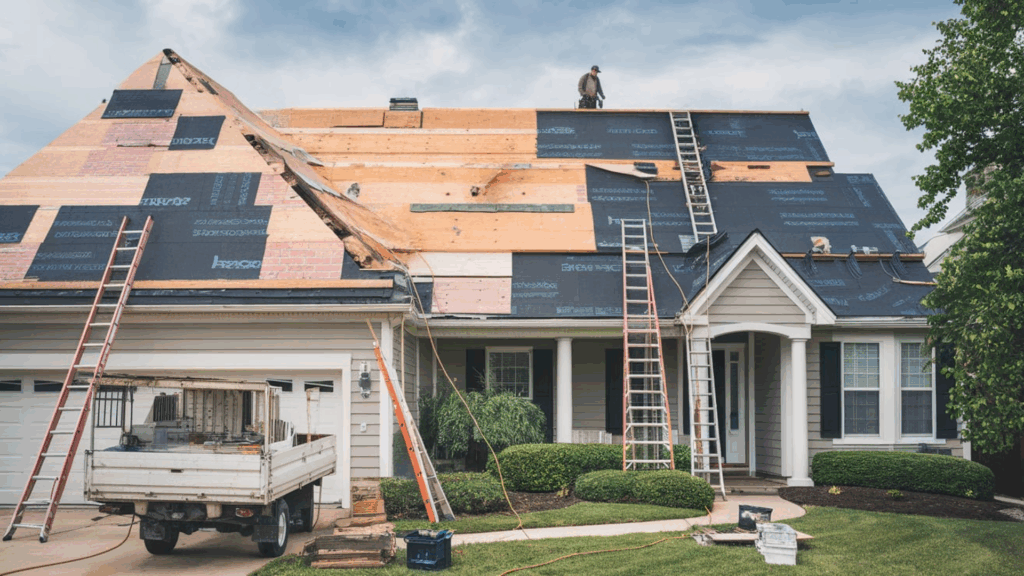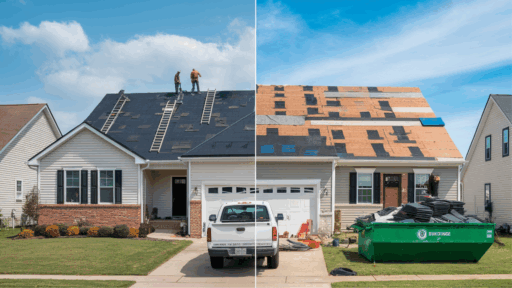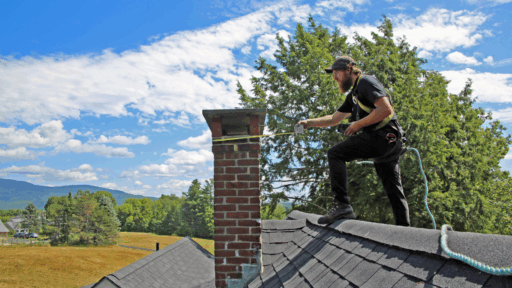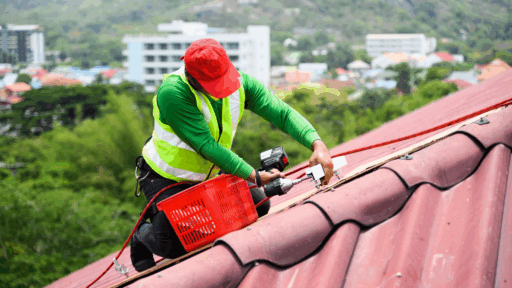Are you unsure whether to repair or replace your roof? I understand; it’s a significant decision.
When I faced the same question, I went back and forth for weeks. What helped me the most was talking to a professional and learning about the signs to watch for.
My advice? Don’t wait until a small issue becomes a big (and expensive) problem. Get a trusted roofer to inspect your roof.
Ask questions. Compare quotes. Weigh both the short-term costs and long-term value.
If you’re still feeling stuck, I’d love to help. I’m happy to share more about my experience and what I learned along the way. Sometimes, a little guidance goes a long way.
You’ve got this, and your roof does too.
Understand the Difference: Roof Repair and Roof Replacement
Roof repair and roof replacement are two distinct solutions, and understanding the differences is crucial for making the right choice.
Roof repair typically involves fixing specific problem areas, like a few missing shingles, minor leaks, or small sections of flashing.
It’s best used when the rest of the roof is still in good shape and the damage is limited.
Roof replacement means removing the old roofing materials and installing a completely new system.
This option is typically necessary when the roof is nearing the end of its lifespan, widespread damage is present, or ongoing issues persist despite previous repairs.
In short, repairs are best for quick, targeted fixes. Replacements offer a more permanent, long-term solution when the roof’s overall condition is failing.
Signs You Might Need a Full Replacement

When problems persist or large areas are affected, a full roof replacement may be the safer and more cost-effective choice.
1. The Roof Is Over 20 Years Old
Most roofing materials have a limited lifespan; for example, asphalt shingles typically last 20 to 25 years.
If a roof is reaching or exceeding that age, it may be more cost-effective to replace it rather than patch up recurring problems.
2. There’s Widespread Shingle Damage
If shingles are curling, buckling, balding (losing granules), or cracking all over, it’s a sign of overall deterioration.
In this case, repairs would only delay the inevitable. Widespread damage compromises the entire roofing system, making a full replacement the safer and more reliable option.
3. You Keep Paying for Frequent Repairs
When roofing issues persist, the cost of repeated repairs can quickly add up. Constant patchwork often means underlying problems aren’t being fully addressed.
If multiple repairs have been made within a short time, a full replacement may be the smarter long-term investment.
Signs You Only Need a Roof Repair

Not every roofing problem necessitates a full replacement. Many common issues can be addressed with simple repairs, especially when the roof is still in good overall condition.
1. There Are a Few Missing or Cracked Shingles
Minor shingle damage is one of the most common reasons for a roof repair.
If only a handful of shingles are missing or damaged due to wind or impact, they can usually be replaced individually without affecting the rest of the roof.
The key is that the problem is localized and not affecting large sections.
2. There Are Small Leaks or Water Stains
Small leaks that appear as water spots on ceilings or walls may stem from minor issues, such as a single compromised shingle, a cracked flashing, or a nail hole.
When caught early, these problems can be repaired before they lead to mold, insulation damage, or rot. Spot treatments are often all that’s needed.
3. The Flashing or Vents Are Slightly Damaged
Flashing and roof vents protect vulnerable areas, such as chimneys and skylights. If these components are loose, slightly rusted, or cracked, repairs can usually restore their seal.
These areas are prone to wear over time but typically don’t require a full roof replacement unless the damage is extensive.
How Roof Age Affects the Decision
When deciding between repairing or replacing a roof, age is one of the most important things to consider. Even if your roof looks okay on the outside, its age can tell a different story.
- Every roof has a lifespan: Asphalt shingles last 20–25 years, wood shingles last about 25–30 years, and metal roofs can last 40 years or more.
- Tile, slate, and concrete roofs last longer: With proper care, they can last 50 to 100 years.
- Old roofs may fail soon: Repairs on an aging roof often don’t last long and can be more costly in the long run.
- Appearance can be misleading: Even without visible damage, an old roof may need to be replaced due to wear below the surface.
- Insurance may not fully cover aged roofs: Older materials may not be covered, especially if the roof has exceeded its life expectancy.
- Maintenance history matters: A well-maintained older roof can outperform a neglected newer one.
- Climate and sun exposure impact lifespan: Harsh weather, poor ventilation, and frequent storms can significantly reduce the lifespan of a roof.
If your roof is near or past its expected age, replacement is usually the smarter and safer long-term choice
Roof Repair vs. Replacement: What to Consider
This section breaks down the most important factors like time, cost, insurance, and home value to help you make a clear, informed decision that fits your home and budget.
Time and Disruption
Time plays a big role when choosing between roof repair and replacement. Repairs are usually fast, often done in a single day, depending on the issue.
Replacements, however, can take several days to over a week, especially for larger or more complex roofs.
Weather delays, material shortages, or needed structural fixes can extend the timeline.
Both options come with some disruption, expect noise, dust, and limited access to parts of your yard or driveway.
While most homeowners can stay in the house during the work is being done, it helps to plan ahead, especially if you have kids, pets, or work from home, to keep things running smoothly.
Cost Comparison
Cost is one of the biggest factors when deciding between a roof repair and a full replacement.
Repairs are more affordable upfront, typically ranging from $150 to $1,500, depending on the issue, materials, and labor costs.
They work well for small problems like missing shingles or minor leaks.
A full roof replacement, however, is a significantly larger investment, typically ranging from $7,000 to $15,000 or more.
Premium materials, such as metal or tile, can increase the price, along with added costs for permits, tear-off, and structural repairs.
While repairs save money in the short term, frequent fixes on an aging roof can add up.
In many cases, replacing the roof can be more cost-effective over time by reducing maintenance needs and improving energy efficiency.
Insurance and Warranty Coverage
Insurance and warranties are critical when weighing the cost and value of roof repairs or replacement. Understanding what is covered and what is not can help homeowners make more informed financial decisions.
- What insurance might cover: Homeowners’ insurance typically covers sudden damage caused by storms, hail, falling trees, or wind. However, it may not cover general wear and tear, neglect, or age-related deterioration.
- Warranty implications of replacing vs. repairing: Full roof replacements usually come with a manufacturer’s warranty on materials and a workmanship warranty from the installer. Repairs may void existing warranties if done improperly or with mismatched materials.
- Potential claim process differences: Insurance claims for a full replacement may require thorough inspections, documentation, and approval from insurance adjusters. Repair claims are often simpler but may be limited in scope. In some cases, a partial payout may be issued, which might not fully cover the needed repairs.
Curb Appeal and Home Value
The condition of a roof plays a big role in a home’s curb appeal and resale potential.
A new roof can significantly boost a property’s value by making the home look well-maintained and move-in ready.
Buyers tend to favor homes with recent roof replacements because they won’t have to budget for repairs or worry about potential leaks.
On the other hand, if repairs are made using materials that don’t match the existing roof, it can create an uneven appearance that detracts from the overall look of the home.
Many buyers also ask about the age of the roof and whether it’s under warranty.
A well-maintained or recently replaced roof can be a strong selling point, while an aging or patchy roof might raise concerns, delay offers, or lead to price negotiations.
Conclusion
Choosing between a roof repair and a full replacement can feel overwhelming, but rushing the decision often leads to more problems later.
Take a look at all the factors like the age of the roof, the extent of damage, the long-term value, and your plans for the home.
Repairs might save money now, but if the roof is nearing the end of its life, replacement could be the smarter investment.
A trusted roofing professional can provide a clear inspection and walk you through the best option for your situation.
Still unsure what to do next? Don’t wait until small problems turn into expensive damage.
Schedule a roof inspection with a qualified contractor. An expert can help you weigh your options with confidence and avoid costly mistakes.
Your roof protects your whole home, make the decision that keeps it strong and reliable.








